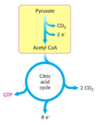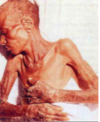8.09 Vitamins Flashcards
(59 cards)
What is a vitamin?
An organic component that has essential biochemical functioning in the body (we cannot live without).
They are not made by the body normally (require intake in the diet)
What are the two broad types of vitamins?
Fat soluble
Water soluble
What are the water soluble vitamins (also give their names) [9]
- Thiamin (B1)
- Riboflavin (B2)
- Niacin (B3)
- Pyroxidine (B6)
- Pantothenic acid
- Biotin
- Folate
- Cobalmin (B12)
- Ascorbic acid (C)
Describe the main difference in digestion and absorption between the water soluble and the fat soluble vitamins
Water-soluble vitamins and minerals do not undergo digestion, as they are already small enough to be absorbed.
Fat soluble vitamins are present in food and require digestion to release. They’re absorption depends on the absorption of fats through the gut
What are the fat soluble vitamins? [4]
- Vitamin K
- Vitamin A
- Vitamin D
- Vitamin E
Describe the digestion process of the fat soluble vitamins
- Digestive processes in the stomach release vitamins from food
- Bile produced in the liver (stored in gall bladder) mixes with chyme and aids fat and vitamin absorption
- Digestive enzymes in the pancreas further release vitamins (especially vitamin A)
What part of the gut does most of the absorption of fat soluble (and the water soluble) vitamins?
Small intestine
Describe the role of microbiota as a source of vitamins
Small amounts of vitamin K and biotin are made by the gut bacteria in the terminal ileum and large intestine and from there they are absorbed
What is the main function of the water soluble vitamins (as a group)
They are enzyme cofactors involved in metabolism and structure (notably collagen).
Which of the vitamins are available over a long peroid of time from the body (ie. storage wise)
The fat soluble vitamins are stored in the liver and can release vitamins when required for a long time from this reserve.
Water soluble vitamins are not stored for long term use (they turn over relatively quickly). Especially thiamin (B1) which is very low in supply.
What is the biological role for thiamin?
Biological role
- A Coenzyme in decarboxylations
- Carbohydrate, protein and fat metabolism
- Nerve function
What are the food sources for thiamin?
Vegemite
Wholemeal breads and fortified cereals
What are the three outcomes that can occur as a result of a thiamin (B1) deficiency?
- Rapid depletion in starvation (stores are very low - high turnover rate)
- Beriberi (DRY: Extreme weakness, paralysis, anaemia and wasting.
- Wernicke-Korsakoff syndrome in alcoholics (
Through bad nutrition and alcohol metabolism destroying thiamine causing eyes to be uncoordinated (nystagmus), wide step, confusion, hypothermia, amnesia and confabulation)
Describe the role of thiamin in metabolism
All energy derived by aerobic metabolism of sugars is dependent on thiamin availability. We need it to convert pyruvate to acetyl CoA (enable glycolysis into the krebs cycle)
In particular, Thiamin is essential for the nerves which are selectively disadvantaged by deficiency.

What is the pathophysiology of Beriberi disease?
Lack of thiamine leads to a wasting away of the neural tissue because it is in high demand/sensitive to lack of energy.
Thiamine is required for the conversion of pyruvate into acetyl-coA and hence there is a deficit of energy in cells.
This leads to peripheral neuropathy characterized by symmetrical impairment of sensory, motor, and reflex functions of the extremities
Note that Wet berberi occurs when serum albumin is low (attack on the liver cells producing albumin) resulting in oedema.
What is the other name for Vitamin B2?
What is it important for in the body?
Riboflavin
- Electron carrier (FMN, FAD)
- Carbohydrate, protein and fat metabolism
What are the food sources of Vitamin B2?
- Vegemite
- milk/cheese
- fortified cereals
What is a riboflavin deficiency? How common is it?
It is Rare (seen mainly only in chronic alcoholics)
- Usually associated with multiple vitamin deficiencies
Tongue in riboflavin deficiency becomes markedly swollen and oedematous and to have a light magenta colour.

What is the specific role of riboflavin (vitamin B2) in metabolism?
Riboflavin is a cofactor in specific oxidation/ reduction reactions including the TCA cycle.
They accept one electron at a time to be accepted and then another accepted. They are important to the cytochromes one at a time and the electron transport chain
What is another name for vitamin B3?
What is the role in the body?
Niacin (nicotinamide, B3)
- Coenzyme
- Electron carrier (NADH, NADPH)
- Carbohydrate, protein and fat metabolism
What are the food sources of vitamin B3 (niacin) ?
- Vegemite
- Wheat bran
- Fortified cereals
Describe the biochemistry of niacin (Vitamin B3)
NAD+ and NADH
Obligate 2 electron acceptor, vital for the krebs cycle and the electron transport chain
Niacin is required for adequate cellular function and metabolism as an essential component in coenzyme I (oxidized form of NAD) and coenzyme II (reduced form of NADP)
What are deficiencies of niacin?
- Alcoholics can have deficiency
- Pellagra (dermatitis, diarrhoea, dementia, death)
Describe pellagra
Historically occured to people who were on a solely corn diet leading to tryptophan and niacin deficiency
- NAD/NADH are able to transfer electrons in a process that captures the energy by generating high-energy phosphate bonds = ATP then provides the energy necessary for other reactions.
- A portion of this cofactor is also converted to NADP/NADPH. Reduced NADPH is used in reactions that detoxify reactive oxygen species, that metabolize drugs in a cytochrome P450 system, and that support lipid biosynthesis.





